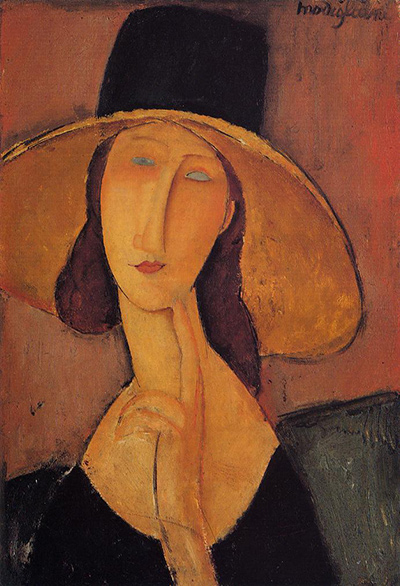The painting Portrait of Jeanne Hebuterne in a large hat was created by Amedeo Modigliani in 1918.
It is an oil on canvas painting that is 15” wide and 21.5” high. It currently hangs in a private collection.
Modigliani was an Italian artist who moved to Paris in 1906. There he became known for his Bohemian lifestyle, with heavy drinking and drug abuse, and for his distinctive, innovative art.
This portrait shows the artist’s partner, Jeanne Hebuterne. She is often referred to as his wife, but the couple never married. Hebuterne was an artist herself, but the day after Modigliani died from tuberculosis as the age of 35, she committed suicide by jumping from a balcony.
This portrait of Jeanne Hebuterne shows her wearing a hat with a wide brim. She has a pensive expression, with one hand raised in front of her with two fingers resting on her chin.
The hat is black on top, with the underside of the brim painted in an earthy brown shade. Her skin tone is a similar shade, but slightly paler. The almond-shaped eyes in the portrait are bright blue.
They are blank-looking, rather than lifelike, and are given very little definition, with no eyelashes or pupils. Hebuterne’s neck and shoulders are bare, with sloping shoulders.
Her round-necked dress is the same black as the crown of her hat, merging with the black couch that she sits upon. The painting’ background is not clearly defined, showing a bare wall in a shade of brown slightly darker than the inside of the hat. The earthy background tones make the creamier face and body stand out in contrast.
We can see Modigliani’s signature distortion and exaggeration, with a long, oval face and long nose. He uses curving, twisting lines. He was strongly influenced by African art, which is reflected in the mask-like face.
There are also echoes of the Renaissance art that was also a huge influence on the painter, with the large hat referencing a halo around Hebuterne’s face. Her expression echoes the beatific, calm faces seen on the statues of saints in Catholic churches, while the position of her raised hand, with its two extended fingers touching her face, echoes a pose which is often seen in Christian art.




